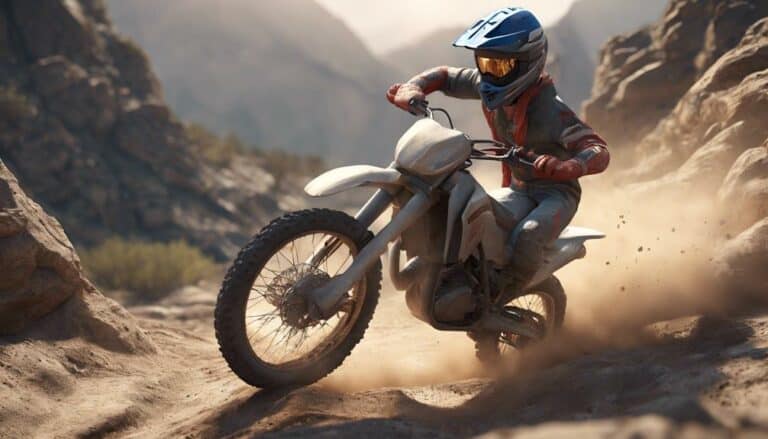Imagine yourself exploring through rugged terrain, feeling the thrill of off-road riding but struggling to maintain balance and control. You seek to master the art of controlling your bike effortlessly over challenging landscapes, but where do you begin?
By focusing on foundational techniques and consistent practice, beginners can enhance their balance and control in off-road riding. Through a combination of body positioning, balance drills, and mastering riding techniques, you can steadily progress towards becoming a confident and skilled off-road rider.
Key Takeaways
- Practice balance techniques on foot pegs and weight distribution.
- Focus on body positioning for enhanced control and stability.
- Engage in drills to improve off-road balance skills.
- Utilize weight transfer strategically for better stability and traction.
Essential Balance Techniques for Beginners
To master essential balance techniques as a beginner off-road rider, focus on maintaining a standing position on the foot pegs while shifting to sitting when necessary. Balancing your weight properly while standing on the foot pegs is important for stability and control when moving through rough terrain.
By staying light on the handlebars and using your legs as shock absorbers, you can improve your balance and maneuverability. Practice changing smoothly between standing and sitting positions, especially before and after corners, to maintain control and momentum through turns.
As you gain confidence in your ability to balance while standing, you'll notice improvements in your overall riding experience. Seeking guidance from a professional trainer can provide valuable tips and techniques to help you overcome any initial challenges and enhance your standing on foot pegs technique.
Body Positioning for Improved Control
For improved control while riding off-road, focus on maintaining a centered sitting position to evenly distribute your weight over the footpegs. This positioning enhances balance and control, allowing you to react more effectively to the challenges of off-road terrain. Additionally, keeping your elbows up while riding is important for better control and leverage when maneuvering through uneven surfaces. By gripping the bike with your legs rather than relying solely on the handlebars, you can achieve a looser grip and greater stability, especially on rough terrain.
To further enhance stability and balance, consider sticking out a leg during cornering to help maintain equilibrium while steering tight turns off-road. Remember to lean the bike into corners instead of your body to maximize grip and control. This technique optimizes stability, ensuring a smoother and more controlled ride on off-road terrain. By mastering these body positioning tips, you can improve your overall control and confidence while riding off-road.
Practice Drills to Enhance Off-Road Balance
Enhance your off-road riding balance through targeted practice drills that focus on improving control and coordination skills. To enhance balance and control, engage in practice sessions that involve slow speed maneuvers. These exercises help you develop the necessary skills to navigate tricky terrains with confidence. Incorporate figure-eight drills into your routine to further enhance your balance and coordination on various surfaces. Additionally, using balance beams or logs to simulate obstacles can help you test your balance adjustments effectively.
Standing position exercises are also vital for improving off-road riding balance. By strengthening your core muscles and enhancing stability, you can better control your bike in challenging conditions. Body positioning drills play a significant role in optimizing weight distribution while riding off-road, contributing to improved balance and control. Practicing these drills consistently will help you master the art of off-road riding and tackle obstacles with ease.
Utilizing Weight Transfer for Stability
By mastering weight transfer techniques through strategic body movements, you can greatly enhance your stability and control while tackling challenging off-road terrains. When facing obstacles and rough terrain, understanding how to shift your weight on the bike is important for maintaining stability. Practice leaning the bike into corners while transferring your weight to the outside footpeg to improve your control over the bike. Proper weight distribution through weight transfer enhances traction, preventing loss of control in challenging conditions. To visualize the impact of weight transfer on stability, refer to the table below:
| Weight Transfer Technique | Effect on Stability | Effect on Control |
|---|---|---|
| Shifting weight forward | Increases stability | Enhances control |
| Shifting weight backward | Decreases stability | Decreases control |
| Leaning into corners | Improves stability | Enhances control |
| Transferring weight to footpeg | Enhances stability | Increases control |
Mastering these weight transfer techniques will empower you to confidently navigate rough trails and obstacles with improved stability and control.
Developing Riding Confidence Through Balance
To boost your riding confidence through improved balance, focus on mastering fundamental techniques that enhance your stability on the bike. Developing a strong sense of balance not only improves your control but also builds muscle memory, allowing you to react instinctively in challenging off-road situations.
Here are some practical steps to help you enhance your riding confidence:
- Practice standing on foot pegs to lower your center of gravity and improve control.
- Focus on keeping your feet on the pegs while cornering to develop muscle memory and balance.
- Use a balance board to simulate dirt bike movements and enhance coordination.
- Seek guidance from a professional trainer to overcome comfort zone limitations and enhance balance.
Conclusion
Congratulations on taking the first steps towards mastering off-road riding! By focusing on equilibrium techniques, body positioning, practice drills, weight transfer, and building confidence, you're on your way to becoming a skilled off-road rider.
Remember, like a well-tuned machine, equilibrium is the key to unleashing your full potential on the trails. Keep practicing, stay determined, and soon you'll be cruising through the dirt with ease and precision.
Happy trails!

